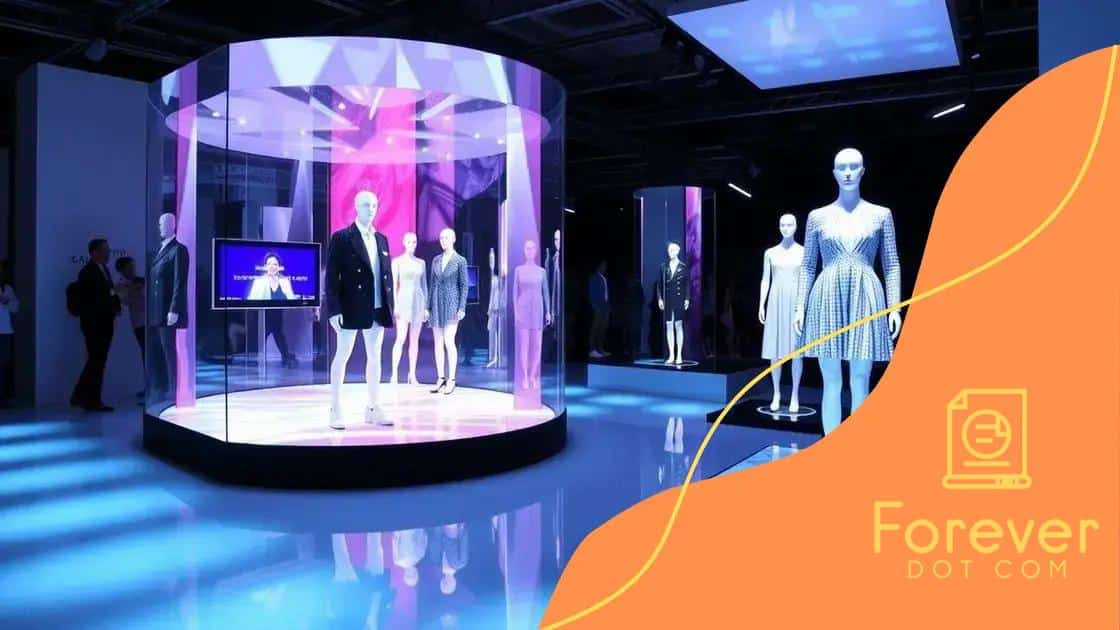The top virtual fashion events of 2025

Virtual fashion events leverage technology to enhance accessibility, engagement, and networking opportunities, allowing designers and participants to connect globally while showcasing innovative collections.
The top virtual fashion events of 2025 promise to revolutionize the way we experience style. With an exciting blend of technology and creativity, these events invite you to immerse yourself in the future of fashion. Ready to discover what’s in store?
Exploring the evolution of virtual fashion
The world of fashion is constantly changing, and exploring the evolution of virtual fashion reveals just how far we’ve come. The rise of technology has transformed not only how fashion is created but also how it is experienced.
The Rise of Digital Fashion
In the early days, fashion was limited to physical runways and clothing racks. However, with the advent of digital tools, designers began to create virtual garments that exist only online. This shift allows for limitless creativity and innovation.
Innovative Platforms
Several platforms have emerged, enabling designers to showcase their work in ways never seen before. These include:
- Virtual fashion shows that reach global audiences.
- Apps allowing users to try on clothes virtually using augmented reality.
- Digital marketplaces for buying and selling virtual clothing.
This evolution creates new opportunities for both established and emerging designers, as they can now showcase their creativity without the restrictions of traditional fashion.
The Role of Social Media
Social media has also played a crucial role in promoting virtual fashion. Influencers and fashion enthusiasts can share their digital outfits, gaining visibility for both virtual brands and designers. This interaction fosters a sense of community and encourages collaboration.
The Future Looks Bright
As technology continues to advance, we can expect to see even more incorporation of virtual elements in fashion. Upcoming trends might include enhanced virtual reality experiences, blockchain for verified digital ownership, and further integration with social platforms.
Digital fashion is not just a trend; it’s a revolution. As we embrace the digital age, understanding this evolution is essential for anyone passionate about fashion.
Key virtual fashion events to watch
When it comes to key virtual fashion events to watch, several gatherings have gained immense popularity. These events not only showcase the latest trends but also engage audiences in innovative ways.
Major Virtual Fashion Shows
Several renowned fashion houses have shifted to virtual platforms. Events such as:
- The Digital Fashion Week, which highlights top designers across the globe.
- The Metaverse Fashion Week, where fashion and technology collide.
- Virtual Capsule Collections, where exclusive pieces are unveiled online.
These shows allow viewers to experience new collections in real-time, transcending geographical barriers.
Interactive Experiences
Many events now offer interactive elements. Here, guests can:
- Participate in live Q&A sessions with designers.
- Engage in virtual meet-and-greets with models and stylists.
- Utilize AR technology to try on clothes digitally.
This kind of engagement enhances the viewing experience, making audiences feel connected to the fashion world.
Sustainability and Inclusivity Focus
These virtual events also emphasize sustainability and inclusivity. Designers are increasingly showcasing:
- Eco-friendly collections made from sustainable materials.
- Diverse models representing all body types and backgrounds.
- Collaborations with emerging designers from various cultures.
This approach promotes a more responsible fashion industry and welcomes a broader audience to participate.
In summary, keeping an eye on these events is vital for anyone interested in the rapidly evolving landscape of fashion. They represent the future, where technology and creativity meet.
How virtual events impact fashion industry trends

How virtual events impact fashion industry trends is a critical aspect of today’s fashion landscape. The pandemic accelerated the need for brands to adapt to digital platforms, reshaping how trends emerge and spread.
Shaping Consumer Expectations
As consumers engage more with virtual fashion, their expectations also change. They now seek:
- Interactive experiences in shows.
- Access to limited-edition drops and virtual goods.
- More transparency about sustainability and production methods.
This shift compels brands to innovate continuously to meet these new demands.
Emergence of New Trends
Virtual events have easy access to data analytics, which reveals emerging trends. Designers and brands can track:
- Real-time feedback from viewers.
- Engagement levels with different styles.
- Popular items and favorite moments during shows.
This analytics-driven approach allows brands to pivot quickly and align their offerings with audience interests.
Collaborations and Partnerships
The virtual space has fostered collaborations among brands that might not have intersected in traditional settings. Designers and tech companies are joining forces to create:
- Augmented reality experiences.
- Virtual fitting rooms with advanced technology.
- Unique, interactive collections that enhance user engagement.
These partnerships lead to innovative products that attract a wider audience while pushing the boundaries of fashion.
In this evolving environment, understanding how these virtual events drive change becomes vital for any fashion enthusiast or industry figure. The integration of technology continues to blur the lines, creating a future where fashion is dynamically interwoven with digital experiences.
The role of technology in virtual fashion events
In recent years, technology has significantly changed the landscape of fashion shows. Understanding the role of technology in virtual fashion events is essential to grasp how the industry is evolving. Virtual events blend creativity and innovation, creating immersive experiences for audiences worldwide.
Enhanced Visual Experiences
Technology allows designers to create stunning visuals that captivate audiences. Features include:
- High-quality 3D graphics that bring designs to life.
- Augmented reality experiences that allow viewers to interact with collections.
- Live streaming options that create a front-row experience for everyone, regardless of location.
These advancements make fashion accessible to a wider audience, breaking down barriers that once defined the industry.
Interactive Engagement
Virtual events also emphasize audience involvement. Attendees are no longer passive viewers; they can:
- Vote on their favorite looks in real time.
- Engage in Q&A sessions with designers and models.
- Customize avatar versions of clothing for a personal touch.
This interactivity creates a sense of community among fashion lovers, connecting them with others sharing the same passion.
Data-Driven Insights
One of the biggest advantages of technology is analytics. Brands can gather data on consumer preferences through virtual events. This includes:
- Tracking viewer engagement during shows.
- Assessing which collections gain the most attention.
- Understanding demographic insights for targeted marketing.
The ability to analyze this data helps brands make informed decisions and adjust their strategies accordingly.
As technology continues to advance, its role in shaping virtual fashion events becomes increasingly vital. The future of fashion lies in this intersection of creativity and technology, setting the stage for exciting innovations to come.
Networking opportunities at virtual fashion gatherings
Networking opportunities at virtual fashion gatherings are transforming how professionals in the industry connect. With a growing emphasis on building relationships online, these events create unique environments for collaboration and growth.
Expanding Reach and Accessibility
Virtual events break down geographical barriers. Attendees from around the world can connect in real time, leading to:
- Increased diversity among participants.
- More varied perspectives and ideas.
- Opportunities to collaborate across different cultures.
This accessibility allows emerging designers and influencers to network with established brands, creating pathways for new partnerships.
Interactive Networking Tools
Many virtual fashion gatherings incorporate interactive tools that facilitate networking. Participants can utilize:
- Virtual chat rooms where they can meet others in the industry.
- Video conferencing platforms for face-to-face discussions.
- Social media integration for sharing ideas and connecting directly.
These tools enhance engagement and make it easier to foster meaningful relationships.
Workshops and Panels for Skill-Building
In addition to traditional networking, virtual events often feature workshops and panels led by industry experts. This setting provides a chance to learn while connecting. Attendees can:
- Gain insights from experienced designers and marketers.
- Ask questions during Q&A sessions.
- Share their experiences in group discussions.
These opportunities not only deepen knowledge but also help participants build connections within their specific areas of interest.
Networking at virtual fashion gatherings therefore offers both immediate and long-term benefits. As the industry evolves, these connections will play a crucial role in shaping the future of fashion.
In conclusion, virtual fashion gatherings are changing the way we connect and collaborate in the fashion industry. These events not only allow for greater accessibility and engagement but also offer valuable opportunities for networking and personal growth. As technology continues to play a significant role, the future of fashion promises to be more inclusive and innovative. Embracing these changes can open doors for both new and seasoned professionals in the field.
FAQ – Frequently Asked Questions about Virtual Fashion Events
What are virtual fashion events?
Virtual fashion events are online gatherings that showcase fashion collections, allowing designers to present their work to a global audience.
How can I participate in these events?
Participation typically involves registering online, and many events offer live streams or interactive features for networking.
What technology is used in virtual fashion events?
These events often use live streaming, augmented reality, and interactive platforms to enhance viewer experience and engagement.
What are the benefits of networking at virtual fashion gatherings?
Networking provides opportunities to meet industry professionals, collaborate on projects, and gain insights from others in the fashion community.






